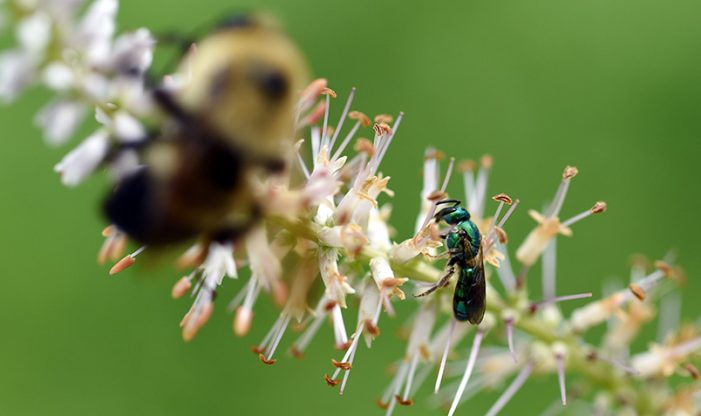In Wisconsin, we have 500 identified species of native bees. Most of them are difficult to see and often go unnoticed. However, they’re all considered keystone members of our ecosystem, meaning they significantly alter the habitat around them and positively affect other organisms. Despite their importance, native bees face pressures due to habitat loss. Gardening with native plants is one way to help bees cope with ongoing threats to their habitat.
Native Bees and the Environment
Bees support native plant communities that provide food and shelter for wildlife. When plants are pollinated, they produce seeds, nuts, and berries that feed birds and help plants propagate. Native bees not only support native habitats, but they also play an important role in pollinating over 100 food crops. It is time we start noticing and appreciating these important insects.
The combination of pesticide use and habitat destruction has had a negative effect on bees. To help them, we can all become backyard beekeepers by enticing native bees to our yards. You can easily provide food and shelter for them in your backyard by creating an attractive landscape of native flowering plants. This will help bees and keep your garden blooming from spring into fall.
The primary native bee families identified at Schlitz Audubon include sweat bees (Halictidae), mining bees (Andrenidae), mason bees (Megachilidae), and bumble bees (Bombus). These native bees co-evolved with native plants to ensure pollination. Typically, each flowering plant has a small team of bees who specialize in pollinating them.
Native Bee Families
Despite the name, the green sweat bee (Agapostemon) is a beauty to behold. These little bees are generally metallic greenish bluish and are fast fliers who specialize in pollinating native blooms. Sweat bees are buzz pollinators like bumble bees and mining bees. Using their jaws, they grasp the flower’s anther and flex their wing muscles to vibrate the pollen off the flower.
Bumble bees are our most recognized and beloved native species. With their large fuzzy bodies, they are sturdy enough to fly in the rain. There are thirteen bumble bee species in Wisconsin, and the yellow banded bumble bee (Bombus terricola) is listed in critical decline. This is a classic looking black and yellow bumble bee, and is more effective in pollinating cranberries, blueberries, and apples than honeybees. This species uses abandoned rodent tunnels to create an underground nest.
Habitat for an Endangered Bee
The Center is home to the rusty patched bumble bee (Bombus Affinis), which is the only federally endangered species in Milwaukee County. In 2018, 16 rusty patched were recorded at the Center’s 185 acres. These findings are a testament to our conservation efforts, and we’re proud to provide a home for this vulnerable native species. All of them have black heads, and males and workers have a rust-colored patch on the center of their back. They occupy grasslands and prairies and need a constant supply of nectar from flowers. Unlike many insects, they are generalists in which prairie flowers they visit.
Mason bees are wood tunneling bees, using twigs and plant stems, wood, or tree stumps, to accommodate their nests. Mason bees (Osimia) species include the orchard mason bee (Osmia lignaria), which have a metallic-blue rounded body with fuzzy undersides. They are well-liked for their pollinating services and many gardeners attract them by setting up nests, which are available for sale in the Nature Store. People can enhance habitat for bees by making their own out of a block of wood mounted on a metal pole, with holes the diameter of a pencil drilled into the wood. You can also make nest boxes using bamboo or cardboard tubes tied in small bundles.
Plant Specific Pollinators
There are 1300 species of mining bees worldwide. In the spring, they are the first native bees on the landscape, pollinating woodland wildflowers, pussy willows, viburnum, and dogwood. In the summer, they are an important Blueberry pollinator, and by fall, they forage on late bloomers like aster and goldenrod. There are different species for different blooms. You can easily see how such a plant specific pollinator could decline once losing habitat.
Gardeners often unintentionally destroy nesting bee sites when digging in the soil, mulching a flower bed, using pesticides, and by keeping a garden too tidy. To support safe habitat, leave large sunny spots on the ground free of mulch and untouched by shovels. Leaving standing dead trees is always great for wildlife habitat, but logs (without bark) and branches are hospitable as well. After pruning shrubs, assume there are bee larvae inside them. Don’t be self-conscious about keeping debris piles and other messy spots in your garden. Educate your skeptical neighbors of your goals and many bees will thank you.
We can all become backyard native beekeepers and support this mutually beneficial relationship. It is a simple and easy way to save the bees and build a better landscape. Plus, solitary bees rarely sting unless provoked!


